五个基本句型例句
五个基本句型及例句

五个基本句型及例句英语的五种基本句型有:主语+谓语(不及物动词) [S + V];例句:(1)The children are playing happily. 孩子们正在高兴地玩。
(2)Everybody laughed. 大家都笑了。
(3)He stands. 他站着。
(4)He swims. 他游泳。
(5)She sings. 她唱歌。
扩展资料6)The student studies. 学生学习。
(7)We arrived. 我们到了。
(8)Time flies. 时光飞逝。
(9)The moon rose. 月亮升起。
(10)The man eat. 那个男人在吃饭。
(11)We all laughed. 我们都笑了。
(12)Everybody talked. 所有人都在讲话。
(13)I laughed. 我笑了。
(14)They cooked. 他们在做饭。
(15)She left.她离开了。
(16)He came.他来了。
(17)She cried.她哭了。
(18)The boy smiled.男孩笑了。
(19)The man died.那个人过世了。
(20)The sun rises.太阳升起来了。
2. 主语+谓语(及物动词)+宾语 [S+V+O]例句:(1)The Greens enjoy living in China. 格林一家喜欢住在中国。
(2)I love apples.我喜欢苹果。
(3)I played the piano. 我弹钢琴。
(4)I like you.我喜欢你。
(5)I hate you. 我讨厌你。
(6)He need a piece of bread. 他需要一片面包。
(7)The monkey eats an banana. 那猴子吃了个香蕉。
(8)She opens the door. 她打开门。
(9)Lucy rides a blue bike. 露西骑一辆蓝色自行车。
英语五个基本句型和例句

英语五个基本句型和例句English Answer:The five basic sentence types in English are:1. Declarative sentences make a statement. They end with a period (.). Example: "The cat is sleeping."2. Interrogative sentences ask a question. They end with a question mark (?). Example: "Where is the cat?"3. Exclamatory sentences express strong emotion. They end with an exclamation point (!). Example: "Wow, that's a beautiful cat!"4. Imperative sentences give a command or request. They end with a period (.). Example: "Please close the door."5. Compound sentences contain two or more independent clauses joined by a conjunction. Example: "The cat issleeping, and the dog is barking."Chinese Answer:英语中的五个基本句型:1. 陈述句用来陈述事实,句末带句号(.)。
例如,“猫在睡觉”。
2. 疑问句用来提问,句末带问号(?)。
例如,“猫在哪儿?”。
3. 感叹句用来表达强烈的情绪,句末带感叹号(!)。
五种基本句型100例句
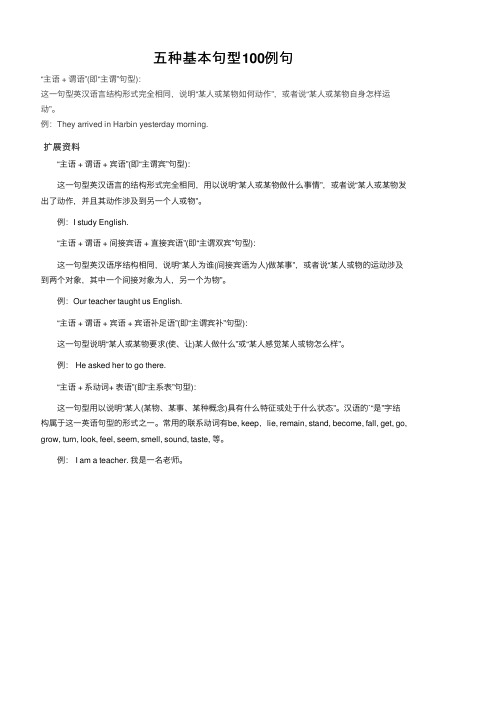
五种基本句型100例句“主语 + 谓语”(即“主谓”句型):这⼀句型英汉语⾔结构形式完全相同,说明“某⼈或某物如何动作”,或者说“某⼈或某物⾃⾝怎样运动”。
例:They arrived in Harbin yesterday morning.扩展资料 “主语 + 谓语 + 宾语”(即“主谓宾”句型): 这⼀句型英汉语⾔的结构形式完全相同,⽤以说明“某⼈或某物做什么事情”,或者说“某⼈或某物发出了动作,并且其动作涉及到另⼀个⼈或物”。
例:I study English. “主语 + 谓语 + 间接宾语 + 直接宾语”(即“主谓双宾”句型): 这⼀句型英汉语序结构相同,说明“某⼈为谁(间接宾语为⼈)做某事”,或者说“某⼈或物的运动涉及到两个对象,其中⼀个间接对象为⼈,另⼀个为物”。
例:Our teacher taught us English. “主语 + 谓语 + 宾语 + 宾语补⾜语”(即“主谓宾补”句型): 这⼀句型说明“某⼈或某物要求(使、让)某⼈做什么”或“某⼈感觉某⼈或物怎么样”。
例: He asked her to go there. “主语 + 系动词+ 表语”(即“主系表”句型): 这⼀句型⽤以说明“某⼈(某物、某事、某种概念)具有什么特征或处于什么状态”。
汉语的`“是”字结构属于这⼀英语句型的形式之⼀。
常⽤的联系动词有be, keep,lie, remain, stand, become, fall, get, go, grow, turn, look, feel, seem, smell, sound, taste, 等。
例: I am a teacher. 我是⼀名⽼师。
简单句的五种基本句型典型例句
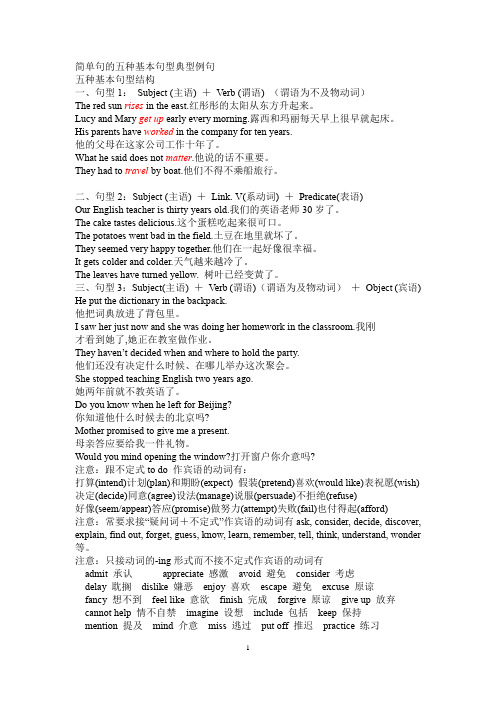
简单句的五种基本句型典型例句五种基本句型结构一、句型1:Subject (主语) +Verb (谓语) (谓语为不及物动词)The red sun rises in the east.红彤彤的太阳从东方升起来。
Lucy and Mary get up early every morning.露西和玛丽每天早上很早就起床。
His parents have worked in the company for ten years.他的父母在这家公司工作十年了。
What he said does not matter.他说的话不重要。
They had to travel by boat.他们不得不乘船旅行。
二、句型2:Subject (主语) +Link. V(系动词) +Predicate(表语)Our English teacher is thirty years old.我们的英语老师30岁了。
The cake tastes delicious.这个蛋糕吃起来很可口。
The potatoes went bad in the field.土豆在地里就坏了。
They seemed very happy together.他们在一起好像很幸福。
It gets colder and colder.天气越来越冷了。
The leaves have turned yellow. 树叶已经变黄了。
三、句型3:Subject(主语) +Verb (谓语)(谓语为及物动词)+Object (宾语) He put the dictionary in the backpack.他把词典放进了背包里。
I saw her just now and she was doing her homework in the classroom.我刚才看到她了,她正在教室做作业。
They haven’t decided when and where to hold the party.他们还没有决定什么时候、在哪儿举办这次聚会。
(完整)英语五种基本句型及例句
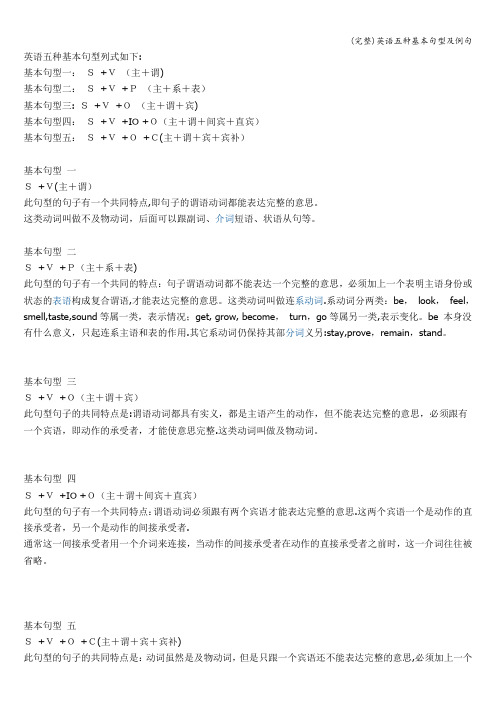
英语五种基本句型列式如下:基本句型一:S+V(主+谓)基本句型二:S+V+P(主+系+表)基本句型三: S+V+O(主+谓+宾)基本句型四:S+V+IO +O(主+谓+间宾+直宾)基本句型五:S+V+O+C(主+谓+宾+宾补)基本句型一S+V(主+谓)此句型的句子有一个共同特点,即句子的谓语动词都能表达完整的意思。
这类动词叫做不及物动词,后面可以跟副词、介词短语、状语从句等。
基本句型二S+V+P(主+系+表)此句型的句子有一个共同的特点:句子谓语动词都不能表达一个完整的意思,必须加上一个表明主语身份或状态的表语构成复合谓语,才能表达完整的意思。
这类动词叫做连系动词.系动词分两类:be,look,feel,smell,taste,sound等属一类,表示情况;get, grow, become,turn,go等属另一类,表示变化。
be 本身没有什么意义,只起连系主语和表的作用.其它系动词仍保持其部分词义另:stay,prove,remain,stand。
基本句型三S+V+O(主+谓+宾)此句型句子的共同特点是:谓语动词都具有实义,都是主语产生的动作,但不能表达完整的意思,必须跟有一个宾语,即动作的承受者,才能使意思完整.这类动词叫做及物动词。
基本句型四S+V+IO +O(主+谓+间宾+直宾)此句型的句子有一个共同特点:谓语动词必须跟有两个宾语才能表达完整的意思.这两个宾语一个是动作的直接承受者,另一个是动作的间接承受者.通常这一间接承受者用一个介词来连接,当动作的间接承受者在动作的直接承受者之前时,这一介词往往被省略。
基本句型五S+V+O+C(主+谓+宾+宾补)此句型的句子的共同特点是:动词虽然是及物动词,但是只跟一个宾语还不能表达完整的意思,必须加上一个补充成分来补足宾语,才能使意思完整.例句1。
They work hard。
主+ 谓2.The flower is dead.主+ 系+ 表3。
Plants need water.主+ 谓+ 宾4。
英语五种基本句型及例子
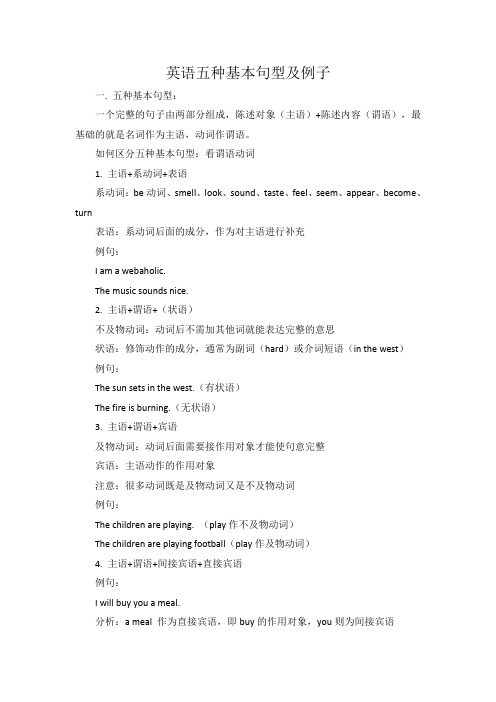
英语五种基本句型及例子一. 五种基本句型:一个完整的句子由两部分组成,陈述对象(主语)+陈述内容(谓语),最基础的就是名词作为主语,动词作谓语。
如何区分五种基本句型:看谓语动词1. 主语+系动词+表语系动词:be动词、smell、look、sound、taste、feel、seem、appear、become、turn表语:系动词后面的成分,作为对主语进行补充例句:I am a webaholic.The music sounds nice.2. 主语+谓语+(状语)不及物动词:动词后不需加其他词就能表达完整的意思状语:修饰动作的成分,通常为副词(hard)或介词短语(in the west)例句:The sun sets in the west.(有状语)The fire is burning.(无状语)3. 主语+谓语+宾语及物动词:动词后面需要接作用对象才能使句意完整宾语:主语动作的作用对象注意:很多动词既是及物动词又是不及物动词例句:The children are playing. (play作不及物动词)The children are playing football(play作及物动词)4. 主语+谓语+间接宾语+直接宾语例句:I will buy you a meal.分析:a meal 作为直接宾语,即buy的作用对象,you则为间接宾语含有两个宾语的为双宾语5. 主语+谓语+宾语+宾语补足语宾语补足语:对宾语进行补充,使句意更完整例句:We elected John our chairman.(我们选了John为主席)John为宾语,our chairman对John进行补充宾语和宾补结合起来叫做复合宾语。
五个基本句型例句
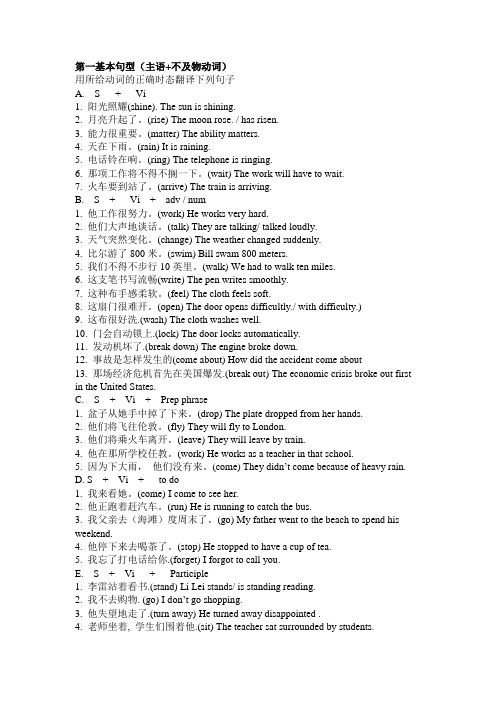
第一基本句型(主语+不及物动词)用所给动词的正确时态翻译下列句子A. S + Vi1. 阳光照耀(shine). The sun is shining.2. 月亮升起了。
(rise) The moon rose. / has risen.3. 能力很重要。
(matter) The ability matters.4. 天在下雨。
(rain) It is raining.5. 电话铃在响。
(ring) The telephone is ringing.6. 那项工作将不得不搁一下。
(wait) The work will have to wait.7. 火车要到站了。
(arrive) The train is arriving.B. S + Vi + adv / num1. 他工作很努力。
(work) He works very hard.2. 他们大声地谈话。
(talk) They are talking/ talked loudly.3. 天气突然变化。
(change) The weather changed suddenly.4. 比尔游了800米。
(swim) Bill swam 800 meters.5. 我们不得不步行10英里。
(walk) We had to walk ten miles.6. 这支笔书写流畅(write) The pen writes smoothly.7. 这种布手感柔软。
(feel) The cloth feels soft.8. 这扇门很难开。
(open) The door opens difficultly./ with difficulty.)9. 这布很好洗.(wash) The cloth washes well.10. 门会自动锁上.(lock) The door locks automatically.11. 发动机坏了.(break down) The engine broke down.12. 事故是怎样发生的(come about) How did the accident come about13. 那场经济危机首先在美国爆发.(break out) The economic crisis broke out first in the United States.C. S + Vi + Prep phrase1. 盆子从她手中掉了下来。
英语五种基本句型及例句
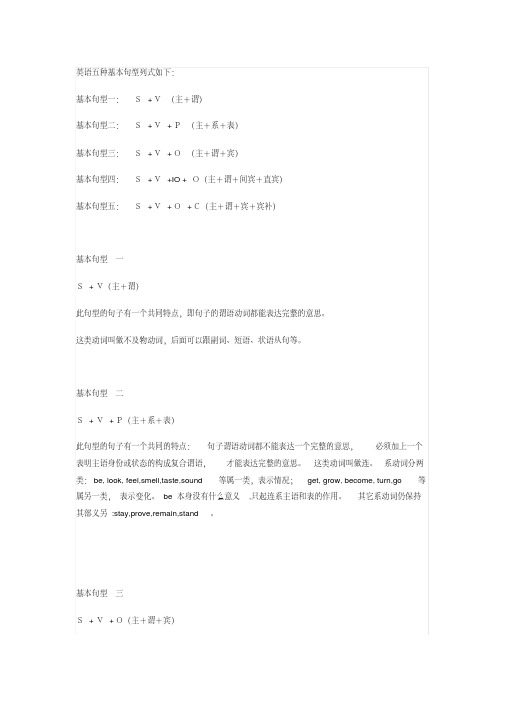
他成为了一名着名的医生。
② The apple pie tastes really delicious.
苹果派吃起来真是好吃。
4. 主语 + 谓语 + 间接宾语 + 直接宾语 [S+V+InO+DO]
这种句型中的及物动词后跟双宾语, 既指人的间接宾语和指物的直接宾语。
也可以把间接宾语放在直接宾语之后,但要加介词
追问: 回答:
追问: 回答: 追问: 回答:
e 额 每个句型举 5 个例子 谢谢
1. 主语 + 谓语 (不及物动词 ) [S + V] 如: The children are playing happily. 孩子们正在高兴地玩。
2. 主语 + 谓语 (及物动词 )+ 宾语 [S+V+O] 如: The Greens enjoy living in China.
英语五种基本句型列式如下: 基本句型一: S + V (主+谓) 基本句型二: S + V + P (主+系+表) 基本句型三: S + V + O (主+谓+宾) 基本句型四: S + V +IO + O(主+谓+间宾+直宾) 基本句型五: S + V + O + C(主+谓+宾+宾补)
基本句型 一 S + V(主+谓) 此句型的句子有一个共同特点,即句子的谓语动词都能表达完整的意思。 这类动词叫做不及物动词,后面可以跟副词、短语、状语从句等。
除了基本句型的成分不变外, 通常是在这些成分的前面或后面增加一些而加以扩大。
这些修
饰语可以是单词(主要是形容词、副词和数词),也可以是各种类型的短语(主要是介词短
五种基本句型 例句 按顺序
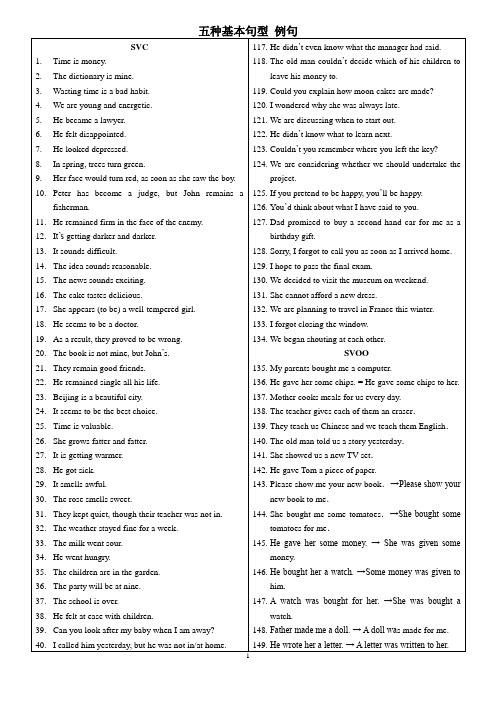
98.His aunt brought an umbrella with her.
99.They stopped talking when they noticed the teacher staring at them at the door.
39.Can you look after my baby whenIam away?
40.Icalled him yesterday, but he was not in/at home.
41.The shop is at the corner.
42.Betty is in front of me.
125.If you pretend to be happy, you’ll be happy.
126.You’d think about whatIhave said to you.
127.Dad promised to buy a second-hand car for me as a birthday gift.
60.We all breathe, drink and eat.
61.Hespeaksquickly.
62.She sings beautifully.
63.This winter snow came early.
64.They came late.
65.The boy was playing in the garden.
76.The students are listening to the teacher carefully.
77.She looked up and smiled.
78.They are not in sight.
英语五种基本句型及例句

英语五种基本句型及例句英语五种基本句型列式如下:基本句型一:S+V(主+谓)基本句型二:S+V+P(主+系+表)基本句型三:S+V+O(主+谓+宾)基本句型四:S+V+IO +O(主+谓+间宾+直宾)基本句型五:S+V+O+C(主+谓+宾+宾补)基本句型一S+V(主+谓)此句型的句子有一个共同特点,即句子的谓语动词都能表达完整的意思。
这类动词叫做不及物动词,后面可以跟副词、介词短语、状语从句等。
基本句型二S+V+P(主+系+表)此句型的句子有一个共同的特点:句子谓语动词都不能表达一个完整的意思,必须加上一个表明主语身份或状态的表语构成复合谓语,才能表达完整的意思。
这类动词叫做连系动词。
系动词分两类:be, look, feel,smell,taste,sound等属一类,表示情况;get, grow, become, turn,go 等属另一类,表示变化。
be 本身没有什么意义,只起连系主语和表的作用。
其它系动词仍保持其部分词义另:stay,prove,remain,stand。
基本句型三S+V+O(主+谓+宾)此句型句子的共同特点是:谓语动词都具有实义,都是主语产生的动作,但不能表达完整的意思,必须跟有一个宾语,即动作的承受者,才能使意思完整。
这类动词叫做及物动词。
基本句型四S+V+IO +O(主+谓+间宾+直宾)此句型的句子有一个共同特点:谓语动词必须跟有两个宾语才能表达完整的意思。
这两个宾语一个是动作的直接承受者,另一个是动作的间接承受者。
通常这一间接承受者用一个介词来连接,当动作的间接承受者在动作的直接承受者之前时,这一介词往往被省略。
基本句型五S+V+O+C(主+谓+宾+宾补)此句型的句子的共同特点是:动词虽然是及物动词,但是只跟一个宾语还不能表达完整的意思,必须加上一个补充成分来补足宾语,才能使意思完整。
例句1.They work hard.主+ 谓2.The flower is dead.主+ 系+ 表3.Plants need water.主+ 谓+ 宾4.He gives me some seeds.主+ 谓+ 直宾+ 简宾5.We should keep the plants in the shade. 主+ 谓+ 宾+ 宾补6.Many animals live in trees.主+ 谓除了基本句型的成分不变外,通常是在这些成分的前面或后面增加一些修饰语而加以扩大。
英语五种基本句型及例子

英语五种基本句型及例子一、SVO句型 (Subject-Verb-Object)在SVO句型中,句子由主语(subject)、动词(verb)和宾语(object)构成。
例子: - I love chocolates. - She eats apples. - They drink tea.二、SV句型 (Subject-Verb)SV句型由主语和动词构成,没有宾语。
例子: - He sleeps. - She sings. - They swim.三、SVC句型 (Subject-Verb-Complement)SVC句型包括主语、动词和补语(complement),补语描述主语或动词。
例子: - She seems tired. - He became a doctor. - They are happy.四、SVOO句型 (Subject-Verb-Object-Object)SVOO句型包含两个宾语,一个是直接宾语(direct object),另一个是间接宾语(indirect object)。
例子: - She gave me a book. - They lent us some money. -He wrote her a letter.五、SVCA句型 (Subject-Verb-Complement-Adverbial)SVCA句型包含主语、动词、补语和状语(adverbial),状语描述动词的详细情况。
例子: - She is happy with the result. - They were surprised by the news. - He feels confident in his abilities.以上是英语中的五种基本句型及相应的例子。
在学习英语语法时,了解这些句型能够帮助我们构建正确且清晰的句子,提高语言表达的准确性和流畅性。
五种基本句型英语例句
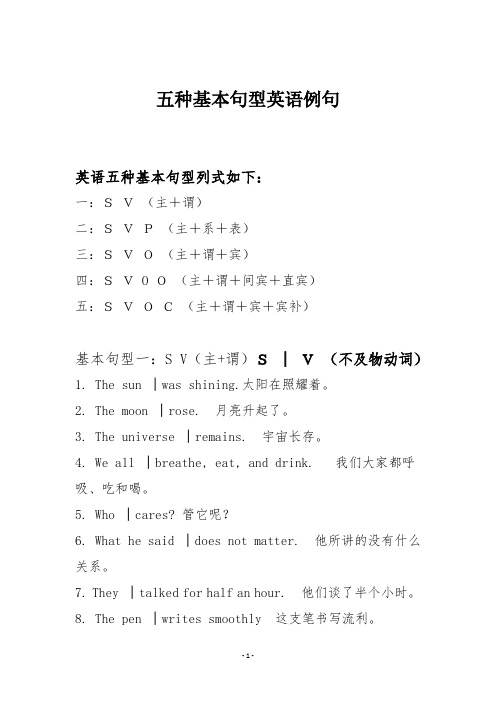
五种基本句型英语例句英语五种基本句型列式如下:一:SV(主+谓)二:SVP(主+系+表)三:SVO(主+谓+宾)四:SV O O(主+谓+间宾+直宾)五:SVOC(主+谓+宾+宾补)基本句型一:S V(主+谓)S│V(不及物动词)1. The sun │was shining.太阳在照耀着。
2. The moon │rose. 月亮升起了。
3. The universe │remains. 宇宙长存。
4. We all │breathe, eat, and drink. 我们大家都呼吸、吃和喝。
5. Who │cares? 管它呢?6. What he said │does not matter. 他所讲的没有什么关系。
7. They │talked for half an hour. 他们谈了半个小时。
8. The pen │writes smoothly 这支笔书写流利。
基本句型二:SVP(主+系+表)此句型的句子有一个共同的特点:句子谓语动词都不能表达一个完整的意思,必须加上一个表明主语身份或状态的表语构成复合谓语,才能表达完整的意思。
这类动词叫做连系动词。
系动词分两类:be, look, keep, seem等属一类,表示情况;get, grow, become, turn等属另一类,表示变化。
be 本身没有什么意义,只起连系主语和表语的作用。
其它系动词仍保持其部分词义。
感官动词多可用作联系动词:look well/面色好,sound nice/听起来不错,feel good/感觉好,smell bad/难闻S│V(是系动词)│P1. This │is │an English-Chinese dictionary.这是本英汉辞典。
2. The dinner │smells │good. 午餐的气味很好。
3. He │fell │in love. 他堕入了情网。
4. Everything │looks │different. 一切看来都不同了。
英语的五大句型10例句
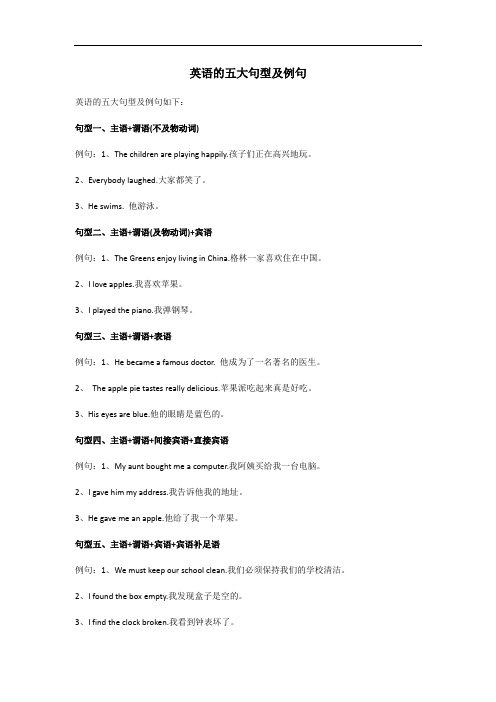
英语的五大句型及例句
英语的五大句型及例句如下:
句型一、主语+谓语(不及物动词)
例句:1、The children are playing happily.孩子们正在高兴地玩。
2、Everybody laughed.大家都笑了。
3、He swims. 他游泳。
句型二、主语+谓语(及物动词)+宾语
例句:1、The Greens enjoy living in China.格林一家喜欢住在中国。
2、I love apples.我喜欢苹果。
3、I played the piano.我弹钢琴。
句型三、主语+谓语+表语
例句:1、He became a famous doctor. 他成为了一名著名的医生。
2、The apple pie tastes really delicious.苹果派吃起来真是好吃。
3、His eyes are blue.他的眼睛是蓝色的。
句型四、主语+谓语+间接宾语+直接宾语
例句:1、My aunt bought me a computer.我阿姨买给我一台电脑。
2、I gave him my address.我告诉他我的地址。
3、He gave me an apple.他给了我一个苹果。
句型五、主语+谓语+宾语+宾语补足语
例句:1、We must keep our school clean.我们必须保持我们的学校清洁。
2、I found the box empty.我发现盒子是空的。
3、I find the clock broken.我看到钟表坏了。
初中英语五种基本句型

( )11.You should study hard .
( )12.The children play football on the playground every afternoon.
A cold kept him in bed for three days. 一次感冒让他卧床三天.
5.主 + 动 + 间宾 + 直宾(SVIODO)常接双宾语的 动词: give , show, tell, teach, pass物动词要求跟两个宾语(双宾语), 即直接宾语和间接宾语.
1.主 + 动(SV)常见的不及物动词: rise wait sleep depend rain smile die
walk dance 等. 例句: 1)The sun has risen . 2) 太阳升起来了.
2) The red sun has risen in the east. 鲜红的太阳在东方升起来了.
9. She taught the children to sing lively songs and perform short and funny plays to cheer them up.
10. You may become unhappy sometimes. S + V + P
4a
Which of the following situations make you sad (S),
基本句型(Basic Sentence Patterns):英语中
英语的句子在结构上可以归纳为五个基本句型
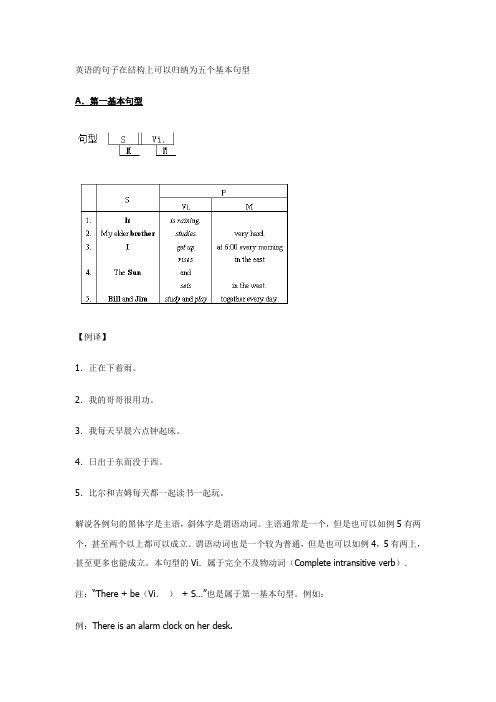
英语的句子在结构上可以归纳为五个基本句型A.第一基本句型【例译】1.正在下着雨。
2.我的哥哥很用功。
3.我每天早晨六点钟起床。
4.日出于东而没于西。
5.比尔和吉姆每天都一起读书一起玩。
解说各例句的黑体字是主语,斜体字是谓语动词。
主语通常是一个,但是也可以如例5有两个,甚至两个以上都可以成立。
谓语动词也是一个较为普通,但是也可以如例4,5有两上,甚至更多也能成立。
本句型的Vi.属于完全不及物动词(Complete intransitive verb).注:“There + be(Vi.)+ S…”也是属于第一基本句型。
例如:例:There is an alarm clock on her desk.(她的书桌上有一个闹钟。
)例:There stands a tower on the hill.(小山上耸立着一座塔。
)B.第二基本句型【例译】1.我的名字是汤姆。
2.约翰和玛丽是同班同学。
3.你准备好了吗?4.所有的问题都不容易回答。
5.你的梦想一定能实现的。
6.这些玫瑰花看起来很美,闻起来也很香。
解说各例句的黑体字是主语,斜体字是谓语动词,字底加线的是主语补语。
什么是主语补语?请观察:①My name is(我的名字是)②These roses look(这些玫瑰花看起来)上面两例虽各有可作主语的名词“name”和“roses”,也有谓语动词“is”和“look”,但是句意不清楚,无法表达完整的句意,所以不是句子。
现在若在例1之后加“Tom”,例2之后加“very beautiful”,那么句意就完整地表达出来了。
像这样,一个词(通常是n.pron.或adj.)在谓语部分里补充说明主语者就叫做主语补语。
主语补语通常是一个,但是依表达的需要也可以有两个(如例6),或更多。
谓语动词需要取主语补语才能把句意表达完整者叫做不完全不及物动词(Incomplete intransitive verb)。
注:下列常见“It…”句式也是属于第二基本句型。
英语中的5种基本句型
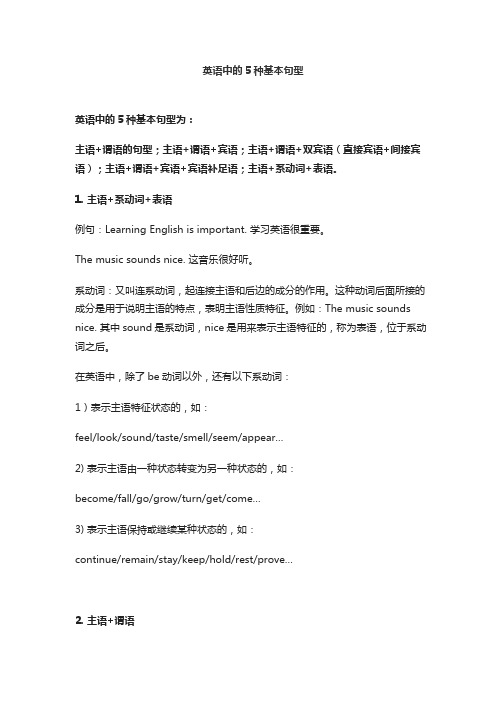
英语中的5种基本句型英语中的5种基本句型为:主语+谓语的句型;主语+谓语+宾语;主语+谓语+双宾语(直接宾语+间接宾语);主语+谓语+宾语+宾语补足语;主语+系动词+表语。
1. 主语+系动词+表语例句:Learning English is important. 学习英语很重要。
The music sounds nice. 这音乐很好听。
系动词:又叫连系动词,起连接主语和后边的成分的作用。
这种动词后面所接的成分是用于说明主语的特点,表明主语性质特征。
例如:The music sounds nice. 其中sound是系动词,nice是用来表示主语特征的,称为表语,位于系动词之后。
在英语中,除了be动词以外,还有以下系动词:1)表示主语特征状态的,如:feel/look/sound/taste/smell/seem/appear…2) 表示主语由一种状态转变为另一种状态的,如:become/fall/go/grow/turn/get/come…3) 表示主语保持或继续某种状态的,如:continue/remain/stay/keep/hold/rest/prove…2. 主语+谓语这个结构中的谓语由不及物动词或短语充当,谓语动词后面常跟状语,来修饰动词,说明动作的程度、发生的地点或时间等等。
例句:He died two years ago. 他两年前死了。
The sun rises in the east and sets in the west. 太阳东升西落。
不及物动词:词典中的注释vi.。
这种动词所表示的动作没有作用对象,其本身意思完整,其后不需要带宾语。
例如:He died.(die是不及物动词,“死”这个动作就只是自主完成,并没有作用对象。
)3. 主语+谓语+宾语该结构中的谓语由及物动词或短语充当。
例句:You have beautiful eyes. 你有美丽的眼睛。
She put the glass down carefullly. 她小心翼翼地放下玻璃杯。
- 1、下载文档前请自行甄别文档内容的完整性,平台不提供额外的编辑、内容补充、找答案等附加服务。
- 2、"仅部分预览"的文档,不可在线预览部分如存在完整性等问题,可反馈申请退款(可完整预览的文档不适用该条件!)。
- 3、如文档侵犯您的权益,请联系客服反馈,我们会尽快为您处理(人工客服工作时间:9:00-18:30)。
第一基本句型(主语+不及物动词)用所给动词的正确时态翻译下列句子A. S + Vi1. 阳光照耀(shine). The sun is shining.2. 月亮升起了。
(rise) The moon rose. / has risen.3. 能力很重要。
(matter) The ability matters.4. 天在下雨。
(rain) It is raining.5. 电话铃在响。
(ring) The telephone is ringing.6. 那项工作将不得不搁一下。
(wait) The work will have to wait.7. 火车要到站了。
(arrive) The train is arriving.B. S + Vi + adv / num1. 他工作很努力。
(work) He works very hard.2. 他们大声地谈话。
(talk) They are talking/ talked loudly.3. 天气突然变化。
(change) The weather changed suddenly.4. 比尔游了800米。
(swim) Bill swam 800 meters.5. 我们不得不步行10英里。
(walk) We had to walk ten miles.6. 这支笔书写流畅(write) The pen writes smoothly.7. 这种布手感柔软。
(feel) The cloth feels soft.8. 这扇门很难开。
(open) The door opens difficultly./ with difficulty.)9. 这布很好洗.(wash) The cloth washes well.10. 门会自动锁上.(lock) The door locks automatically.11. 发动机坏了.(break down) The engine broke down.12. 事故是怎样发生的?(come about) How did the accident come about?13. 那场经济危机首先在美国爆发.(break out) The economic crisis broke out first in the United States.C. S + Vi + Prep phrase1. 盆子从她手中掉了下来。
(drop) The plate dropped from her hands.2. 他们将飞往伦敦。
(fly) They will fly to London.3. 他们将乘火车离开。
(leave) They will leave by train.4. 他在那所学校任教。
(work) He works as a teacher in that school.5. 因为下大雨,他们没有来。
(come) They didn’t come because of heavy rain.D. S + Vi + to do1. 我来看她。
(come) I come to see her.2. 他正跑着赶汽车。
(run) He is running to catch the bus.3. 我父亲去(海滩)度周末了。
(go) My father went to the beach to spend his weekend.4. 他停下来去喝茶了。
(stop) He stopped to have a cup of tea.5. 我忘了打电话给你.(forget) I forgot to call you.E. S + Vi + Participle1. 李雷站着看书.(stand) Li Lei stands/ is standing reading.2. 我不去购物. (go) I don’t go shopping.3. 他失望地走了.(turn away) He turned away disappointed .4. 老师坐着, 学生们围着他.(sit) The teacher sat surrounded by students.5. 他哭着走来,笑着离开.(come, leave) He came crying, but left smiling.第二基本句型:(主语+ 系动词+ 表语)翻译下列句子A. S + Link-v + n. / pron. / 名词所有格1. 那是一张世界地图。
That is a map of the world.2. 那张地图是我的。
The map is mine.3. 那听起来像个好主意。
(sound) That sounds a good idea.4. 失败是成功之母。
Failure is the mother of success.5. 那辆自行车是李雷的。
That bike is Li Lei’s.6. 他成了一名律师。
He became a lawyer. / turned lawyer.B. S + Link-v + adj.1. 这儿的天气糟糕透了。
The weather here is terrible.2. 孩子们饿了。
The children are hungry.3. 物价涨高了。
(run) The prices ran/ are running high.4. 这些玫瑰气味很香。
(smell) The roses smell sweet.5. 牛奶已变质。
(go) This milk has gone bad.6. 他的梦想实现了。
(come) His dream has come true.7. 春天来了。
树木变绿了。
(turn) Spring comes and the trees turn green.8. 他看上去很镇静。
(appear) He appeared calm.9. 多雨的天气可能会持续几天。
(continue) The rainy weather will continue several days.C: S + Link-v + adv.1.海伦不在家,她出去了。
(in, out) Helen isn’t in. She is out.2.我们该走了。
(off) We must be off now.3.好的,我马上就下(楼)来。
(down) All right, I’ll be down immediately.4.电视还开着。
(on) The TV set is still on.5.你什么时候回来?(back) When will you be back?6.他离开半个钟了。
(away) He has been away for half an hour.7.雷锋去世40年了。
Lei Feng has been dead for 40 years.8.会议结束了。
(over) The meeting is over.9.你的朋友不在这儿,他在那儿。
(here, there) Your friend is not here. He is there.10.我彻夜未眠。
(up) I was up all night.D: S + Link-v + prep phrase1.他很健康。
(in good condition) He is in good condition./in good health.2.他脱离了危险。
(out of danger) He was out of danger.3.这个问题很重要。
(of great importance) The question is of great importance.4.他昨天上午在工作。
(at work) He was at work yesterday morning.5.他在住院。
(in hospital) He is in hospital.6.他值班。
(on duty) He is on duty.7.我们完全支持你。
(behind you) We are fully behind you.E: S + Link-v + participle1.门锁上了。
(locked) The gate/ door was locked.2.他讲的话鼓舞人心。
(encouraging) His words were encouraging.3.我们深受鼓舞。
(encouraged) We are greatly encouraged.4.她总是显得很开心、幸福和满足。
(pleased, contented) She always seems/ appearspleased, happy and contented.5.边界问题仍然没得到解决。
(unsolved) The boundary question remainedunsolved.基本句型三主语+ 谓语+ 宾语A S + Vt + n/pron1. 谁知道答案?1. Who know knows the answer?2. 我们去看望了城里的朋友。
(visit)We visited our friends in town.3. 我不懂古典文学。
(understand)I can’t understand classical literature.4. 他们在会上看到了他。
They saw him at the meeting.5. 明天我要到机场接你。
. I’ll meet you at the airport tomorrow.6. 我以前看过这个电影。
I have seen the film before.7. 规矩点。
(behave oneself)You should behave yourself.8. 他献身于教育。
He devoted himself to education.9. 他现在能自己穿衣服了。
She can dress herself now.10. 他过着幸福的生活。
She lives a happy life.11. 她做了个噩梦。
She dreamed a terrible dream.12. 我昨晚睡了个安稳觉。
(sleep a peaceful sleep)I slept a peaceful sleep last night.B S + Vt + n/pron + prep-phrase1. 我们应该保护她免遭危险。
(protect …from….)We should protect her from danger.2. 他抓住我的胳膊。
